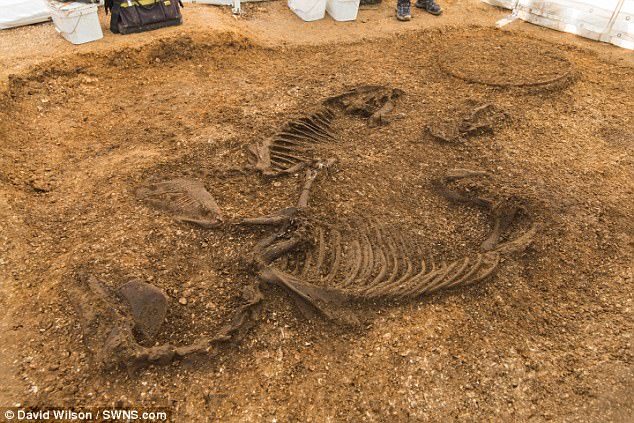
An Iron Age chariot and two horse skeletons have been unearthed.
An Iron Age chariot and two horse skeletons have been unearthed at a Yorkshire building site. The
2,500-year-old remains have been dubbed by experts as 'highly unusual'. The find is the first of its kind in the last 200 years and one of only 26 ever excavated in the UK.It has been described as a find of 'international significance'. The peculiar remains were found at a new housing development in Pocklington, East Yorkshire, which has forced planners to hold off on their builds. Archaeologists working on the site say that the remains may link to a strange human burial ritual.
Additional imagesFurther testing and analysis of the remains is expected to reveal more information.
Paula Ware, from MAP Archaeological Practice, told
BBC News that the find could shed more light on Iron Age burial rituals.
She said that the positioning and close proximity of the horses to the chariot suggests they played a key role in the burial ceremony.
Ms Ware added that the 'rare discovery' would help researchers better understand the Arras culture - a group of people who lived in the region at the time
In 2014 a housing developer stumbled upon the site and now the ancient settlement is said to be of extreme 'national and international significance'.
Since then archaeologists have excavated more than 75 Iron Age burial graves, known as 'barrows'.
Last year, a buried Iron Age fighter was found at the site, which experts believe was once a migrant camp.
The remains were of a man in his late teens or 20s, who died with his sword at his side. Before his death he reportedly had six spears pressed into him 'like a hedgehog'.
The amazing find will allow the largest study of an Iron Age population in the last 35 years, developers at the site said.
Developer David Wilson Homes found the settlement at its Pavilion Square site after breaking ground in September 2014.
Excavation at the site has already revealed a haul of Iron Age objects, including a sword, a shield and ten spears.
In addition to the weapons, more than 360 amber and glass beads, brooches and ancient pots have been unearthed.
A spokesman from the developers said the majority of barrows excavated have been well-preserved, with only a few being damaged by soil conditions and ploughing.
A major focus area of the archaeological analysis will concentrate on whether the population is indigenous, or migrants from the European continent.
Analysis will also hopefully reveal how those buried at the site died, what stresses their bodies had been placed under during their lifespan, and whether or not they were related.
The findings additionally revealed a mixture of men, women and children.
'To date, the east of Yorkshire has the largest concentration of 'Arras Culture' square barrows, and naturally these findings have helped to strengthen this,' said Paula Ware, managing director at MAP Archaeological Practice.
'We are hoping that these findings shed light on the ritual of Iron Age burial - and, as we can assume from the shield and sword burials, these were significant members of society, so our understanding of culture and key figures of the time could be really enhanced.
'On the whole this is a hugely important discovery and is a fine example of what can be revealed and discovered if house developers and archaeologists work hand-in-hand to reveal the nation's hidden history.'
Reader Comments
to our Newsletter